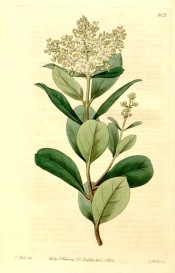Olea capensis L.
Shrub or bushy tree with leathery oval leaves, to 6cm long, shiny above, pale beneath, and crowded terminal panicles of white flowers in summer and autumn. To 5m. [RHSD].
Horticultural & Botanical History
Introduced to Britain in 1730. [JD]. ‘Our plant belongs to the variety (alpha) coriacea of the Olea capensis of the Species Plantarum of Willdenow; a variety which has been since separated by the same author, in his Enumeratio, from (beta) undulata, as a distinct species. Undulata has been figured and described in the Hortus Schoenbrunnensis of Jacquin. Native of the Cape of Good Hope. Cultivated in this country at Eltham, by Dr. Sherard before 1730. Blossoms in the greenhouse in autumn and winter. […] The fruit is a small oblong Olive, at no stage, we believe, applicable to the purposes of oeconomy, to which the European Olive is applied.’ [BR f.613/1822].
History at Camden Park
Presented to the Sydney Botanic Gardens in 1823 by Edward Macarthur. It may not have been planted at Camden Park although it seems likely that William would have wanted it for his new garden.
Notes
Olea capensis Buchoz ex Roem. & Schult. (1817) = Pterocelastrus tricuspidatus Walp.
Published Jan 20, 2010 - 04:39 PM | Last updated Jan 20, 2010 - 04:45 PM
| Family | Oleaceae |
|---|---|
| Category | |
| Region of origin | South Africa |
| Synonyms | |
| Common Name | |
| Name in the Camden Park Record |
Olea capensis |
| Confidence level | high |


